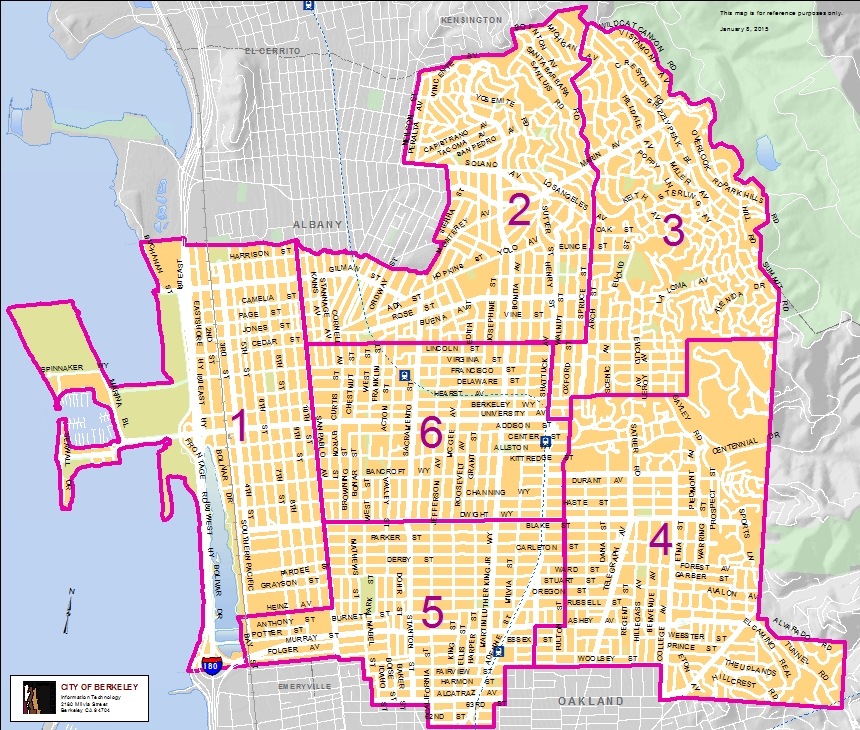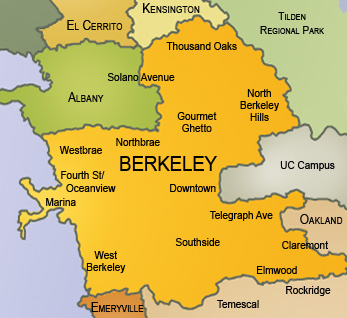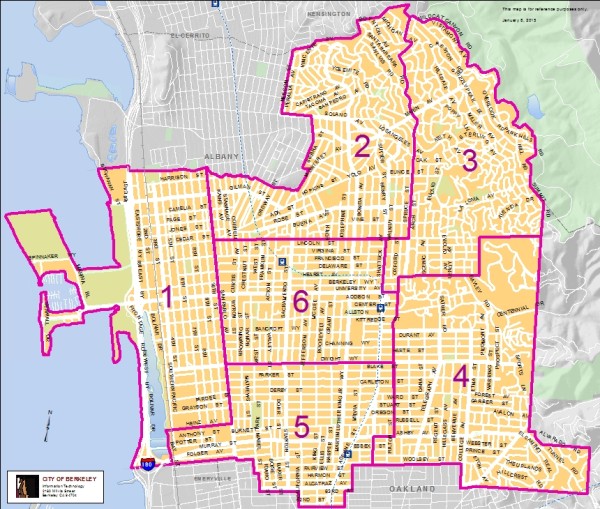
Real Estate Information & Attractions in Berkeley, CA


Berkeley Overview:
Berkeley is a relatively small urban enclave, with a wide range of neighborhoods. Celebrated for its cultural diversity, dynamic academic life and gourmet restaurants, it is the college town sensibility that unites the city into an interesting and exciting place to call home.
Berkeley is famous (infamous) for the heady days of the Free Speech Movement at the University of California, but these days it’s best known as a haven for the epicurean delights that started in the North Berkeley neighborhood known as the “Gourmet Ghetto.” This is the home of the nationally acclaimed Chez Panisse Restaurant, Peet’s Coffee and Tea, and the Cheese Board collective.
From the glorious bay views seen from the hills, to the charming Victorians and bungalows in the “flats,” and the stately old homes of the Elmwood district, Berkeley is a unique and beautiful town. Many Berkeley homes are notable for their singular architectural styles, some of which were designed by the architects Bernard Maybeck, John Hudson Thomas, and Julia Morgan.
Berkeley has the added advantage of being conveniently connected by BART, bus and bridge with the larger cities of San Francisco and Oakland.
Berkeley boasts numerous neighborhood parks, wonderful walking paths that straddle the hills, and at its easternmost boundary, the 2,074 acre Tilden Regional park, featuring hiking and biking trails, Lake Anza, the historic Merry-Go-Round, Steam Train, and the Little Farm Nature Area.
Claremont
The manicured gardens and stately
real estate of the Claremont define this upscale neighborhood as much as the grand 19th century hotel that gives this wooded, southeast corner of Berkeley its name.
Many of the homes have unparalleled views of the San Francisco Bay and skyline. Parks and hidden paths enhance the natural beauty of the surroundings. The homes and mansions of the Claremont area include Prairie styles, shingled cottages, Italian villas, Spanish period revivals, and many contemporary designs.
Some of the contemporary homes situated high in the hills attest to the draw of this area. Despite the fire of 1991 that destroyed many of the hillside homes, most residents chose to rebuild and reclaim their dreams, embodied in architectural gems that maximize the dramatic setting.
Downtown Berkeley
Berkeley’s central downtown is a lively and exciting place. According to the Downtown Berkeley Association, the city center is the fastest growing housing market in Berkeley. Living downtown in one of the new mixed use
real estate developments, or neighboring single-family homes, allows residents access to everything they need—an entire array of retail shops, services, movie theaters, and culture—within easy walking distance. From its vibrant theater district to its festive Saturday Farmers’ Market, downtown offers a host of activities.
First established in 1876, the downtown didn’t really take off until after the 1906 earthquake. Most of the retail shops along both sides of Shattuck Avenue, named for one of the city’s first developers, were built in the early years of the twentieth century. While the facades have since been updated, the original historic character and small-town flavor can be glimpsed in the architectural details by looking above the entry levels of many of the buildings.
Berkeley is well known as a center of academia and cultural diversity. Its downtown puts the best of small town and big city living at your feet.
Walk to:
- Downtown Berkeley BART
- Saturday Farmers’ Market
- Central Library
- YMCA health club
- The Berkeley Repertory and the Aurora Theaters
- Freight and Salvage — Home of Traditional Music
- U.C. Berkeley Campus and Zellerbach Theater
- Over 100 restaurants which feature cuisines from more than 15 countries
Elmwood
The quiet, tree-lined streets of the Elmwood district evoke a stately turn-of-the-century sensibility. The
real estate is a mix of classic brown shingles, period revivals, Craftsmen bungalows, and cottages complete with English gardens. Even the shops along the Elmwood stretch of College Avenue suggest a small town of decades past.
Here you will find unique, locally owned shops, cafes, restaurants, a bookstore, bakery and a refurbished movie theater. The Elmwood is a wonderful walking neighborhood that puts everything you need within easy reach. Excellent access to freeways and public transportation make it easy to get almost anywhere in the Bay Area.
The Gourmet Ghetto
The Gourmet Ghetto of North Berkeley takes its name from the elegant and wholesome food and dining options situated along this northern stretch of Shattuck Avenue. A food revolution began here in 1967, beginning with Peet’s Coffees and Teas and the Cheese Board, a collective that features cheeses from all over the world. The neighborhood was ripe for Alice Waters’ Chez Panisse restaurant when it opened in 1971. Taking a cue from the way the French shopped for food, cooked, and ate, using fresh, locally grown products, Waters has been credited with ushering in California Cuisine.
Today, the area has great restaurants, bakeries and coffee houses galore. But food isn’t the only attraction. Here, the business corridor gives way to leafy, quiet residential
real estate along streets that begin to ease their way up into the hills. Homes tend to be larger and many have stunning bay views. The Queen Anne Victorians and turn-of-the-century homes that survived the 1923 fire are mixed in among brown shingles, Colonial revivals and Craftsmen bungalows. The close proximity of homes to major shopping makes the Gourmet Ghetto a true walking neighborhood of the sort one might find in Paris or New York.
- Thursday Farmers’ Market
- Numerous houses of worship of many different denominations
- Public transportation
- Two public parks with tennis courts
- Elementary and middle schools close by
Marina
The Berkeley Marina is the westernmost portion of the city of Berkeley, located west of Interstate 80 and 580, at the foot of University Avenue on San Francisco Bay. Narrowly speaking, “Berkeley Marina” refers only to the city marina, but in common usage, it applies more generally to the surrounding area.
There are several restaurants, a hotel and a yacht club in the Berkeley Marina. There are also several walking and bicycle paths. The area is accessible from the rest of Berkeley by foot or bike over the Berkeley I-80 Bridge at the foot of Addison Street (one block south of University Avenue), and is traversed near Interstate 80 by a segment of the San Francisco Bay Trail. In addition, it is accessible by AC Transit.
The easternmost portion of the Marina, running parallel to I-80/580, is now a part of the Eastshore State Park.
The North Berkeley Hills
Along the winding and sometimes steep streets of the north Berkeley hills, lush gardens and wooded parks with stunning natural rock formations abound. Here, the turn-of-the-century Craftsmen aesthetic created a fine sensibility in the many homes designed by some of Berkeley’s luminary architects—Bernard Maybeck, Julia Morgan, John Hudson Thomas, and William Wurster—all of whom created understated elegant homes, which showcase elements of the Arts and Crafts movement in the architecture, interior design, and even in the gardens.
All took inspiration from the beauty of the natural setting, but no one style of architecture dominates. Italian villas, Spanish haciendas, Tudor manors and mid-century Modern homes share the spotlight. A walker’s paradise, the hills are intersected by 136 quaint paths. Hiking, golf, and horseback riding are minutes away in Tilden Park, which runs along the easternmost boundary of the hills. Tennis courts are situated throughout the hills. And of course, watching a magnificent sunset over the Golden Gate Bridge from any number of vista points, including many a private home’s bay window, is a popular pastime. Residents in the north Berkeley Hills enjoy country living in a city setting.
- Proximity to the U.C. Campus
- Lawrence Hall of Science
- The Rose Garden
- Easy access to San Francisco and downtown Berkeley via public transportation
- Tilden Park attractions
- Botanical Gardens of Tilden Park
Northbrae
Overlooking the sparkling waters of the San Francisco Bay and snugly nestled in the Berkeley foothills, Northbrae is sheltered and protected from the heat of summer and the chill of winter. Designed as one of the first planned residential parks, we love Northbrae for its broad, curving roads, five rock gardens, pink sidewalks, panoramic vistas, lush foliage, and street names elegantly carved in stone pillars.
Northbrae’s original developer, Duncan McDuffie, was a member of the Sierra Club who promoted environmentally sensitive development and made sure that the natural landscape worked in harmony with the surroundings. Streets are laid out in graceful curves along the contours of the hills, in a general northerly and southerly direction, thus giving every house an unbroken view of the Bay on one side and the Berkeley Hills on the other. Today, these homes still consist of variations on the Craftsman bungalows and period revival homes.
Northbrae has a number of its own and nearby community gems, including Indian Rock Park, Cedar Rose Park (Cedar Rose Park), Arthur Putnam’s four sculptured bears in the Arlington Circle fountain, and the beautiful Peralta community garden where families can be found picnicking on the benches around its lovely pond. Residents also enjoy public tennis courts, play areas, a swimming pool and a track as well as a well-stocked branch library housed in a lovely Julia Morgan building. There is also a plethora of interesting shops and restaurants nearby.
Fourth Street / Oceanview
Ocean View, the oldest enclave in Berkeley, is an exciting mix of renovated and new housing and retail properties. The neighborhood’s historic legacy is still evident in its architecture. Early Victorians and Neo-Colonial homes are situated among the brown shingled cottages and California bungalows built between 1910 and the 1950s.
Fourth Street, Ocean View’s main commercial area, has become Berkeley’s most upscale and popular shopping destination. Its numerous home décor shops, restaurants, cafes, and specialty shops line the broad tree-lined boulevard, drawing families and friends from near and far to enjoy the open-air promenade.
There is a “mini” Amtrak station at Fourth Street & University Avenue, and access to AC Transit buses. The pedestrian bridge that crosses the freeway to the extensive Berkeley Marina Parks area is also here. Berkeley is truly a walker-friendly town, from the Bay to the Hills.
back to top
Southside
Just south of the UC Berkeley campus, Southside is a bustling, student-oriented area, and wins our vote for the most colorful and vibrant neighborhood in the East Bay. Students, homeowners and curious tourists happily meander through endless cafes, eclectic bookstores, record shops, and very diverse restaurants on busy Telegraph Avenue, the hub of activities south of campus.
Southside is proudly home to the work of Berkeley’s first planners and architects. Julia Morgan, Bernard Maybeck, and other virtuoso architects designed many of the buildings, and Frederick Law Olmsted (designer of Central Park and Golden Gate Park) had a hand in planning the leafy residential streets southeast of campus. Their influences can be seen on the dense, tree-lined side streets where homes include restored Victorians, Neo-Colonial boxes, vernacular-style bungalows, and shingled cottages. Many of these homes feature separate, self-contained “in-law” units, which can provide additional income for homeowners who wish to rent them to students.
Thousand Oaks / Solano
Thousand Oaks is an idyllic Berkeley suburb in an inspiring setting. The original town planners worked to create a balance between the existing natural environment and the buildings. Granite boulders and trees were left standing, roads followed the contours of hills, and all of it was enhanced with lush plantings and colorful flowers. Today, the neighborhood remains a lovely retreat.
Early on, Craftsman bungalows and shingled lodges were sprinkled throughout the community. Later, between 1910 and 1940, Thousand Oaks saw period revivals in Spanish, Tudor, and French Provincial styles. These magnificent homes still remain, and are enhanced by mature oak trees and the neighborhood’s lush, landscaped walking paths, creeks, and bucolic parks.
Many features make Thousand Oaks appealing, among them the walking paths to Solano Avenue, homes with bay views, a strong community feeling, and express transportation to San Francisco. In 1996, residents working with UC Berkeley, the City of Berkeley, and local Realtors restored the Marin Circle Fountain with its iconic California bears.
The area’s shopping district is along Solano Avenue, a charming, tree-lined boulevard of locally owned shops and restaurants. Residents enjoy an array of dining options including Nepalese, Tibetan, Thai, Japanese, Chinese, Vietnamese, Indian, Italian, and California cuisine. For grocery shopping, we love the small family-owned groceries that specialize in Italian, Middle Eastern, or Asian foods.
West Berkeley
This old, established Berkeley neighborhood has a small town feel. 1920s bungalows, turn-of-the-century homes, and a few Victorian farmhouses that date back to Berkeley’s beginnings intermingle here. At the core of this tree-lined neighborhood is the 13+-acre San Pablo Park, serving the residents with tennis and basketball courts, a recreation center, large playing fields, and picnic area with barbeques and playground.
The quality of life is further enhanced by paths for biking and jogging, numerous small parks and playgrounds, and proximity to Aquatic Park, great for dog walking, fishing, kayaking and wind surfing.
The vibrant shopping area along San Pablo with its array of restaurants, coffee houses and stores is an easy walk. Opportunities for finding a home here abound, and this area provides good value for homeownership in Berkeley.
Close to:
- Great shops and service centers
- Berkeley Bowl produce market
- Ashby Lumber & Plumbing and OSH Hardware
- Ashby BART station and weekend Flea Market
Westbrae
One of Berkeley’s most affordable communities, Westbrae is an older Berkeley neighborhood full of character, cultural diversity, and residential tranquility. Gorgeous community gardens, a spacious park, playgrounds, a soccer field and beautiful
real estate make it an ideal place to raise a family. When it comes to homes for sale in Berkeley, Marvin Gardens has you covered!
Westbrae’s tree-lined streets are attractive and well kept. Homebuyers have their choice of Craftsman bungalows, Spanish Revival cottages, and post-war suburban-style homes, as well as a few remaining early Victorians and farmhouses from when the town was first settled.
The jewel of Westbrae is the three-acre Cedar Rose Park, a grassy expanse featuring two fenced children’s playgrounds, picnic areas and public tennis courts. A jogging track, pool, and more are open to the public at the local middle school. For shopping, Gilman Street is the spot. Some of our favorite places are Boogie Woogie Bagel Boy, Berkeley Natural Grocery, Coffee Conscious, and New Leaf Garden Gallery, which specializes in garden fountains and sculptures.
Panoramic Hill
Named “Berkeley’s Most Romantic Neighborhood” by the Berkeley Architectural Heritage Association (Berkeley Architectural Heritage Association), Panoramic Hill is well deserving of this accolade. Surrounded on three sides by rustic canyons, hiking trails, ridges and open land, the Hill offers a rare combination of natural beauty, spectacular vistas, environmentally sensitive development, and convenience to the University and downtown Berkeley.
Tucked away in on the wooded slopes southeast of the University, this remote, unspoiled enclave is dotted with one-of-a-kind “vernacular” homes which have been designed to offer glimpses of natural beauty and rustic architecture while complementing their hilly, irregular lots. Crafted of natural materials and built in subtle harmony amidst these natural settings, Panoramic Hill features no less than eleven homes listed in the State Historic Resources Inventory, including homes designed by Julia Morgan and Walter Steilberg. Some of the most sought-after homes are the simple brown-shingled cottages and bungalows by famed California architect Bernard Maybeck. Creativity continues to flourish on the Hill with a number of unusual contemporary homes including a Frank Lloyd Wright Usonian house and a recent renovation by California architect Mark Mack designed to take advantage of the many commanding views from the Hill.
Most of the homes for sale on the Hill are within walking distance to the open spaces of Strawberry and Claremont Canyons.
